'An actor is one who is made and not one who is born'
should be the motto of the Sinhala theatre
by Prof. Ariya Rajakaruna
Translated by Ranga Chandrarathne
Continued from 21 December 2006
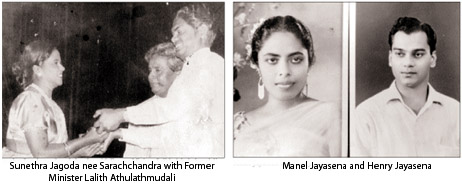 A Critique on the State Sinhalese Drama Festival of 1966. A Critique on the State Sinhalese Drama Festival of 1966.
(This is a translation of a critique by Prof. Ariya Rajakaruna. He
served as the Head of the Department of Sinhala of the University of
Peradeniya. He is currently a visiting lecturer attached to the
Departments of Fine Arts and Sinhala. This is the only comprehensive
review written on any State Sinhala Drama Festival held during the last
five decades. This review was first published in 1967. This critique has
been translated for the first time.)
Apparently, there are no special skills and aptitude on the part of
the dramatists to keep the audience's attention intact according to the
techniques of realistic drama.
The producer of Ahas Maliga (The Glass Menagerie) was able to make
use of out-of-the theatre techniques such as focusing of the spotlight
on the narrator at the start and at the end of the drama while the whole
audience is in the dark, the narrator addressing the audience from the
highest step of the fleet of steps to the house, mother and daughter
watch the moon sitting on the fleet of steps, son holding a newspaper
apparent to the audience through the thin curtain when he enters home
with the guest, son carrying out a conversation with the guest on the
fleet of steps, a sudden black out of the stage and lighting a candle,
to intensify the zest of the drama.
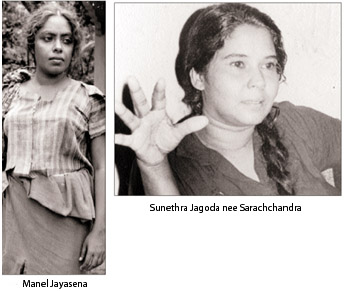 The playback music which is intermittently heard from the start to
the end of the drama, even at times when absolutely nothing is happening
on the stage is able to attract the audience's attention to the stage.
Mahinda Dias has craftily used lighting on the stage. The playback music which is intermittently heard from the start to
the end of the drama, even at times when absolutely nothing is happening
on the stage is able to attract the audience's attention to the stage.
Mahinda Dias has craftily used lighting on the stage.
Though Jayasena's language does not possess the same poetic quality,
Jayasena has been able to use the language with some aptitude. The
producer's attempt to create a conducive atmosphere for an 'unnatural
drama' has been successful to a certain degree.
In terms of acting, a certain degree of discipline can be seen in
Jayasena's drama. However, Jayasena does not possess a skillful team of
actors and actresses compared to Sugathapala de Silva, which is
perceived as a weakness.
Amanda Wingfield created by Williams is a complex character. Manel
Jayasena fails to portray every aspect of Mother's character derived
from Amanda Wingfield. She was able only to portray some aspects of that
character. Henry Jayasena as son and Grace de Silva as daughter show
certain skills. In some instances, the influence of Western film acting
can be observed in Jayasena's acting. A weakness of Grace de Silva is
that she cannot speak loud to the audience.
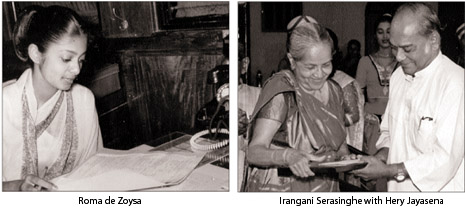 Dhamma Jagoda and Hector Rupasinghe adapted Tennessee Williams's "A
Streetcar Named Desire" (1947) into the Sinhala theatre as "Wes Muhunu".
"A Streetcar Named Desire" is a symbolic title for Tennessee Williams'
drama while 'Wes Muhunu' is an expression born out of distortion of the
drama. When some instances from 'Wes Muhunu' were taken for observation,
it is obvious that the drama is not apt for Sri Lankan society. Dhamma Jagoda and Hector Rupasinghe adapted Tennessee Williams's "A
Streetcar Named Desire" (1947) into the Sinhala theatre as "Wes Muhunu".
"A Streetcar Named Desire" is a symbolic title for Tennessee Williams'
drama while 'Wes Muhunu' is an expression born out of distortion of the
drama. When some instances from 'Wes Muhunu' were taken for observation,
it is obvious that the drama is not apt for Sri Lankan society.
However, in a complete sense, it does not portray an indigenous
environment. The objective of the dramatist is to underscore a conflict
between two societies superseding the complexities of Blanche's
character. Kumari Udawela (Roma de Zoyza), a character derived from
Blanche's character, appears for feudalism.
Her sister (Sunetra Jagoda) who is married to Samson Silva (Dhamma
Jagoda) represents lumpen society. What is the conflict between lumpen
society and feudal society? The drama is based on an imaginary conflict
between these two social strata. No such conflict between two social
strata is being reflected through the characters of Kumari Uduwela and
Samson Silva.
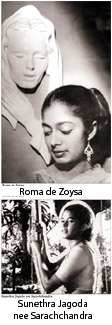 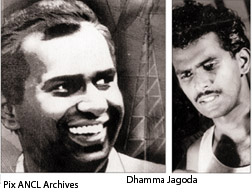 It is obvious that the attempt at portraying Kumari Udawela's
character as one that has sprung from Sri Lankan society by the adapter
has failed. The sense of depth in the original play has not been found
in the Sinhalese adaptation. As the dramatist strives hard to make the
production natural which arouse feelings, the language in some parts of
the adaptation is weak as well as crude. It is obvious that the attempt at portraying Kumari Udawela's
character as one that has sprung from Sri Lankan society by the adapter
has failed. The sense of depth in the original play has not been found
in the Sinhalese adaptation. As the dramatist strives hard to make the
production natural which arouse feelings, the language in some parts of
the adaptation is weak as well as crude.
There are some significant aspects in 'Wes Muhunu'. A certain
influence of Sugathapala de Silva's techniques of play production is
manifested in 'Wes Muhunu'. The producers were able to attract the
audience's attention by employing out-of-the theatre techniques. Samson
Silva, entering the stage and throwing a parcel of meat at Swarna Silva
is such a technique that attracted the audience's attention.
Peep out from the rear window and speak out, observing the scene
inside the house, walking up and down along the steps has been used with
some understanding of the craft. From the start to the end, the drama
was staged in a stress- free manner.
Sunethra Jagoda who portrayed the character of Swarna Silva acted
naturally. As she was able to speak loud without betraying the fact that
she by-hearted the words, it seems that she has some understanding of
the Theatre and Acting. However, the major weakness in Sunetra's acting
is that she was not so skillful in her facial expressions.
Roma is a rare actress who is suited to portray complex urban
characters and also seems an actress who mastered the natural drama (Swabhavika
natya). She had an understanding of the characters she portrayed which
is lacking in most Sri Lankan actresses and an ability to illustrate a
range of emotions through facial expressions. She uses her entire body
in acting to express emotions.
The manner in which she behaved upon the stage suggests that she
really likes acting. However, she was virtually stranded between
Williams's Blanche and Dhamma Jagoda's Kumari Uduwela. Her acting in the
penultimate scene was weak. There were many instances where she lost her
natural acting due to reading between lines and delivering dialogues in
a way betraying the fact that she by-hearted them.
The producers should be commended for introducing Roma de Zoysa, who
portrayed the character of Kumari Uduwela, to the Sinhala theatre. It
does not, however, suggest that she did her part well.
Roma has the ability to become an accomplished actress at the hand of
a skillful producer. Dhamma Jagoda as Samson Silva showed as an actor
who could portray certain types of characters successfully.
[email protected] |



 A Critique on the State Sinhalese Drama Festival of 1966.
A Critique on the State Sinhalese Drama Festival of 1966.  The playback music which is intermittently heard from the start to
the end of the drama, even at times when absolutely nothing is happening
on the stage is able to attract the audience's attention to the stage.
Mahinda Dias has craftily used lighting on the stage.
The playback music which is intermittently heard from the start to
the end of the drama, even at times when absolutely nothing is happening
on the stage is able to attract the audience's attention to the stage.
Mahinda Dias has craftily used lighting on the stage.  Dhamma Jagoda and Hector Rupasinghe adapted Tennessee Williams's "A
Streetcar Named Desire" (1947) into the Sinhala theatre as "Wes Muhunu".
"A Streetcar Named Desire" is a symbolic title for Tennessee Williams'
drama while 'Wes Muhunu' is an expression born out of distortion of the
drama. When some instances from 'Wes Muhunu' were taken for observation,
it is obvious that the drama is not apt for Sri Lankan society.
Dhamma Jagoda and Hector Rupasinghe adapted Tennessee Williams's "A
Streetcar Named Desire" (1947) into the Sinhala theatre as "Wes Muhunu".
"A Streetcar Named Desire" is a symbolic title for Tennessee Williams'
drama while 'Wes Muhunu' is an expression born out of distortion of the
drama. When some instances from 'Wes Muhunu' were taken for observation,
it is obvious that the drama is not apt for Sri Lankan society. 
 It is obvious that the attempt at portraying Kumari Udawela's
character as one that has sprung from Sri Lankan society by the adapter
has failed. The sense of depth in the original play has not been found
in the Sinhalese adaptation. As the dramatist strives hard to make the
production natural which arouse feelings, the language in some parts of
the adaptation is weak as well as crude.
It is obvious that the attempt at portraying Kumari Udawela's
character as one that has sprung from Sri Lankan society by the adapter
has failed. The sense of depth in the original play has not been found
in the Sinhalese adaptation. As the dramatist strives hard to make the
production natural which arouse feelings, the language in some parts of
the adaptation is weak as well as crude. 







